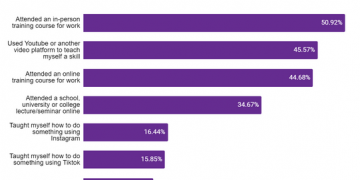
Dealing With A Hostile Audience
Not everyone will like you.
That is a fact of life.
Throughout your career, you will have to work with all sorts of different types of people.
Some you will get along with, some you won’t.
You will need to learn to deal with hostile people/audiences.
As we saw in our last article, if you understand your audience then there are tried and tested way to influence them, and bring them around to your way of thinking.
Who Is A Hostile Audience?
A hostile audience is simply anyone who has an issue with your topic or with you as an individual.
They may be hostile by nature, or there may be an underlying reason for their behaviour.
The thing you need to remember is that hostile people are just like you and me, but they are feeling helpless, wronged, or overlooked for some reason.
To better understand hostile people, check this article that lists the following types of a hostile audience:
- The Heckler
- The Over-zealous
- The Squawker
- The Turned-off
- The Lost
- The Expert
The more you understand the reason for their hostility, the more you can adjust your approach to deal with their issues.

9 Ways To Deal With A Hostile Audience
“The most important single ingredient in the formula of success is knowing how to get along with people.” – Theodore Roosevelt.
Knowing your audience well is crucial to your success.
A hostile audience will not agree with you. They may even be working against you.
Lets look at some tried and tested ways to deal with hostile audiences.
1. Use humour to break the ice
Humour works well when you don’t overdo it.
In his book, “You Just Have to Laugh,” the stand-up comic David Naster emphasises the importance of humour as an effective tool in dealing with difficult people.
“Laughing can be an incredible emotional release, and it eliminates the negatives that cause tension in our lives,” says Naster. “When you laugh, you blow out internal negative garbage.”
Using humour will make your audience less tense and consequently less hostile.
2. There is always some common ground
No matter how much you disagree with someone, you still may have some points to agree on.
It might be harder than finding common ground with people you already get along with. However, it will pay off when you can connect with your hostile audience.
Try to find the aspects that you can agree on with hostile people. You can do this by focusing on shared interests.
For example, if you meet with an angry customer, ensure that you both are working to resolve the issue and focus on that. Your common goal is the customer’s satisfaction.
3. Set clear goals
Do not set unrealistic expectations for your communication. You are very unlikely to be able to convert a hostile audience completely to your way of thinking. Aim to change their minds on a few key points.
Being clear from the beginning about your goals will spare you disappointments.
Plan your goals and be flexible about them.
4. Increase credibility
Since your audience is set against you, they will question every piece of information presented to them.
Be prepared with facts, statistics, and resources. Do your research beforehand.
When discussing a problem with a hostile audience, try to present realistic, actionable solutions. When you offer a solution, make sure that you are committed to it.
Promising your employee a raise when he’s aware you can’t afford it is not very wise. He will figure out that you are just trying to win him over with false promises.
Being honest with your hostile audience may not win you the conversation right away, but it will build trust in the long term.
5. Stay Calm
Do not attack your audience or their position. Do not let them turn you into a hostile person.
When they ask you provoking questions, try to remain calm. Stay professional and don’t indicate that their negative attitude has hurt you in any way.
When you are relaxed, you are in control of the conversation. Everyone prefers to work with calm people.
6. Focus on a win-win outcome
Throughout your communication with a hostile audience, make it clear that you are looking for a win-win outcome.
They need to know that you are determined to solve the problem in the best possible manner for both sides.
It’s not about you winning an argument – you just want to reach the best possible outcome.
7. Build rapport
Communication through computers, emails, and messaging has become very cold and impersonal.
Connect to the human aspect of your work relationship.
Go out for dinner or drinks with your difficult colleagues and learn more about their personalities. This will help you a lot when you are dealing with them in challenging work situations.
8. Use logical reasoning
Logic and basic reasoning are the best way to sort out objective, technical problems.
Evidence-based reasoning is hard to disagree with. When you use logic to solve a problem, you appeal to your audience’s rational mind. This makes them set emotions aside and analyse things before reacting to what you are saying.
9. Connectivity is key
The rule of connectivity states that the more we establish a connection with people, the more we can persuade them. Building a bond with your audience will make them more comfortable around you.
The hostile audience is not hostile towards you on purpose – there are certain reasons triggering their behaviour.
When hostile people start feeling comfortable around you, they will express their ideas freely. You will know the reasons behind their hostility. Then you will be able to understand the situation and adjust your approach.

3 Mistakes To Avoid When Dealing With A Hostile Audience
Let’s also have a look at three very common mistakes that people make, to help you avoid them.
1. Trying to fight fire with fire
We’re wired to react to aggression with even more aggression. This is “fighting fire with fire”, which results in destruction and compromised relationships.
No matter how experienced you are, you may still fall into this trap because it’s part of your human nature.
We can avoid this by preparing and training ourselves before interacting with someone who’s hostile. There are techniques we can learn to help us succeed at confrontations without fighting back with aggression.
Here are five principles that we can learn to put out the fire:
· Listen, paraphrase, and empathise
· Never react in anger
· Never defend yourself
· Redirect the focus
· Develop exit strategies
Practising these principles will give you the calmness needed to handle a hostile audience.
2. Not addressing the elephant in the room
Ignoring the elephant in the room means ignoring the reason for that person’s hostility or delaying the bad news you need to deliver.
This will annoy your audience more. Address the issue as soon as possible. This will quickly disarm your hostile audience. They may even calm down just because they feel seen and understood.
3. Ending the conversation with questions
A common mistake is to invite your hostile audience to ask questions at the very end of the conversation.
Some of the questions will probably stir up negative feelings again, and if this is the last thing they hear, that is what they’ll remember.
Instead, save some time at the very end of your meeting to summarise your ideas. People tend to disproportionately remember what was last said, so try to end the conversation with your points.
Conclusion
Getting a hostile audience to listen to you is your ultimate goal.
By following these techniques, you can make any hostile audience more easily manageable. Once they listen to you, you can start convincing them with your ideas.
You may even move them to a neutral audience, or better a positive one.
Dealing with a hostile audience cannot be avoided. It’s part of our professional life and can be make or break for your career.
Luckily, there are tried and tested methods to calm hostile people down and win them round to your way of thinking.
To learn more about presentation skills for managers, read our article on this subject.


